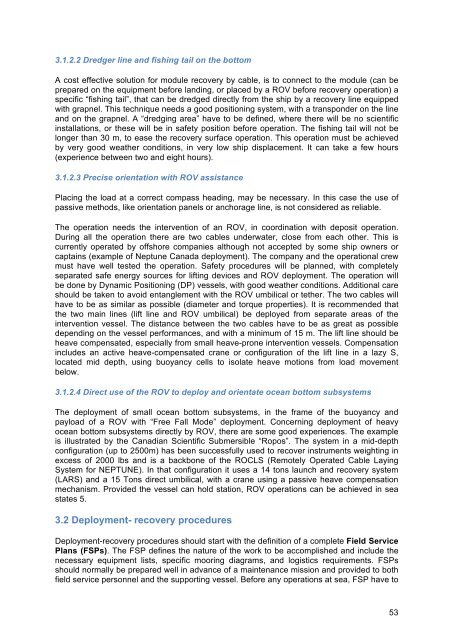Handbook of best practices
Handbook%20of%20best%20practices
Handbook%20of%20best%20practices
You also want an ePaper? Increase the reach of your titles
YUMPU automatically turns print PDFs into web optimized ePapers that Google loves.
3.1.2.2 Dredger line and fishing tail on the bottom<br />
A cost effective solution for module recovery by cable, is to connect to the module (can be<br />
prepared on the equipment before landing, or placed by a ROV before recovery operation) a<br />
specific “fishing tail”, that can be dredged directly from the ship by a recovery line equipped<br />
with grapnel. This technique needs a good positioning system, with a transponder on the line<br />
and on the grapnel. A “dredging area” have to be defined, where there will be no scientific<br />
installations, or these will be in safety position before operation. The fishing tail will not be<br />
longer than 30 m, to ease the recovery surface operation. This operation must be achieved<br />
by very good weather conditions, in very low ship displacement. It can take a few hours<br />
(experience between two and eight hours).<br />
3.1.2.3 Precise orientation with ROV assistance<br />
Placing the load at a correct compass heading, may be necessary. In this case the use <strong>of</strong><br />
passive methods, like orientation panels or anchorage line, is not considered as reliable.<br />
The operation needs the intervention <strong>of</strong> an ROV, in coordination with deposit operation.<br />
During all the operation there are two cables underwater, close from each other. This is<br />
currently operated by <strong>of</strong>fshore companies although not accepted by some ship owners or<br />
captains (example <strong>of</strong> Neptune Canada deployment). The company and the operational crew<br />
must have well tested the operation. Safety procedures will be planned, with completely<br />
separated safe energy sources for lifting devices and ROV deployment. The operation will<br />
be done by Dynamic Positioning (DP) vessels, with good weather conditions. Additional care<br />
should be taken to avoid entanglement with the ROV umbilical or tether. The two cables will<br />
have to be as similar as possible (diameter and torque properties). It is recommended that<br />
the two main lines (lift line and ROV umbilical) be deployed from separate areas <strong>of</strong> the<br />
intervention vessel. The distance between the two cables have to be as great as possible<br />
depending on the vessel performances, and with a minimum <strong>of</strong> 15 m. The lift line should be<br />
heave compensated, especially from small heave-prone intervention vessels. Compensation<br />
includes an active heave-compensated crane or configuration <strong>of</strong> the lift line in a lazy S,<br />
located mid depth, using buoyancy cells to isolate heave motions from load movement<br />
below.<br />
3.1.2.4 Direct use <strong>of</strong> the ROV to deploy and orientate ocean bottom subsystems<br />
The deployment <strong>of</strong> small ocean bottom subsystems, in the frame <strong>of</strong> the buoyancy and<br />
payload <strong>of</strong> a ROV with “Free Fall Mode” deployment. Concerning deployment <strong>of</strong> heavy<br />
ocean bottom subsystems directly by ROV, there are some good experiences. The example<br />
is illustrated by the Canadian Scientific Submersible “Ropos”. The system in a mid-depth<br />
configuration (up to 2500m) has been successfully used to recover instruments weighting in<br />
excess <strong>of</strong> 2000 lbs and is a backbone <strong>of</strong> the ROCLS (Remotely Operated Cable Laying<br />
System for NEPTUNE). In that configuration it uses a 14 tons launch and recovery system<br />
(LARS) and a 15 Tons direct umbilical, with a crane using a passive heave compensation<br />
mechanism. Provided the vessel can hold station, ROV operations can be achieved in sea<br />
states 5.<br />
3.2 Deployment- recovery procedures<br />
Deployment-recovery procedures should start with the definition <strong>of</strong> a complete Field Service<br />
Plans (FSPs). The FSP defines the nature <strong>of</strong> the work to be accomplished and include the<br />
necessary equipment lists, specific mooring diagrams, and logistics requirements. FSPs<br />
should normally be prepared well in advance <strong>of</strong> a maintenance mission and provided to both<br />
field service personnel and the supporting vessel. Before any operations at sea, FSP have to<br />
53


